These no-bake chocolate peanut butter balls come together with a simple 5-ingredient filling, just like these peanut butter egg candies. For the coating, chop and melt real chocolate, and follow all my success tips to make dipping easy. These candies are as soft as chocolate truffles and as irresistible as peanut butter cups!
I originally published this recipe in 2019 and have since added new photos and a video tutorial, and I have also made a small change to the peanut butter filling. See recipe Notes for original filling recipe.

While there’s no disputing that peanut butter + chocolate is a winning combination, there is a lot of competition vying for the title of Best Chocolate-Peanut Butter Treat. While I love peanut butter blossoms and these no-bake chocolate peanut butter bars—oh, and this decadent dark chocolate peanut butter cake is a favorite special-occasion indulgence—I think the prize for Best All-Around goes to these simple peanut butter balls.
One reader, Krista, commented: “This recipe has become part of my regular Christmas baking and sometimes in the random moment. Thank you for bringing a new baking tradition to our home. My husband and son love them. ★★★★★”
One reader, Lana, commented: “I made these for my son for Valentine’s Day and he (we!) LOVED them! They are to DIE for! I roasted and salted some Spanish peanuts I had, chopped them fine, and then sprinkled them all over the top. Delish! ★★★★★“
Honestly the Best Peanut Butter Balls
And here’s why:
- Soft + creamy peanut butter filling, similar to the middle layer in this Reese’s peanut butter white chocolate bark
- Smooth + rich chocolate coating
- Easy to make no-bake recipe
- Make-ahead & freeze beautifully
- Recipe doubles easily, and a tin of these makes a wonderful gift
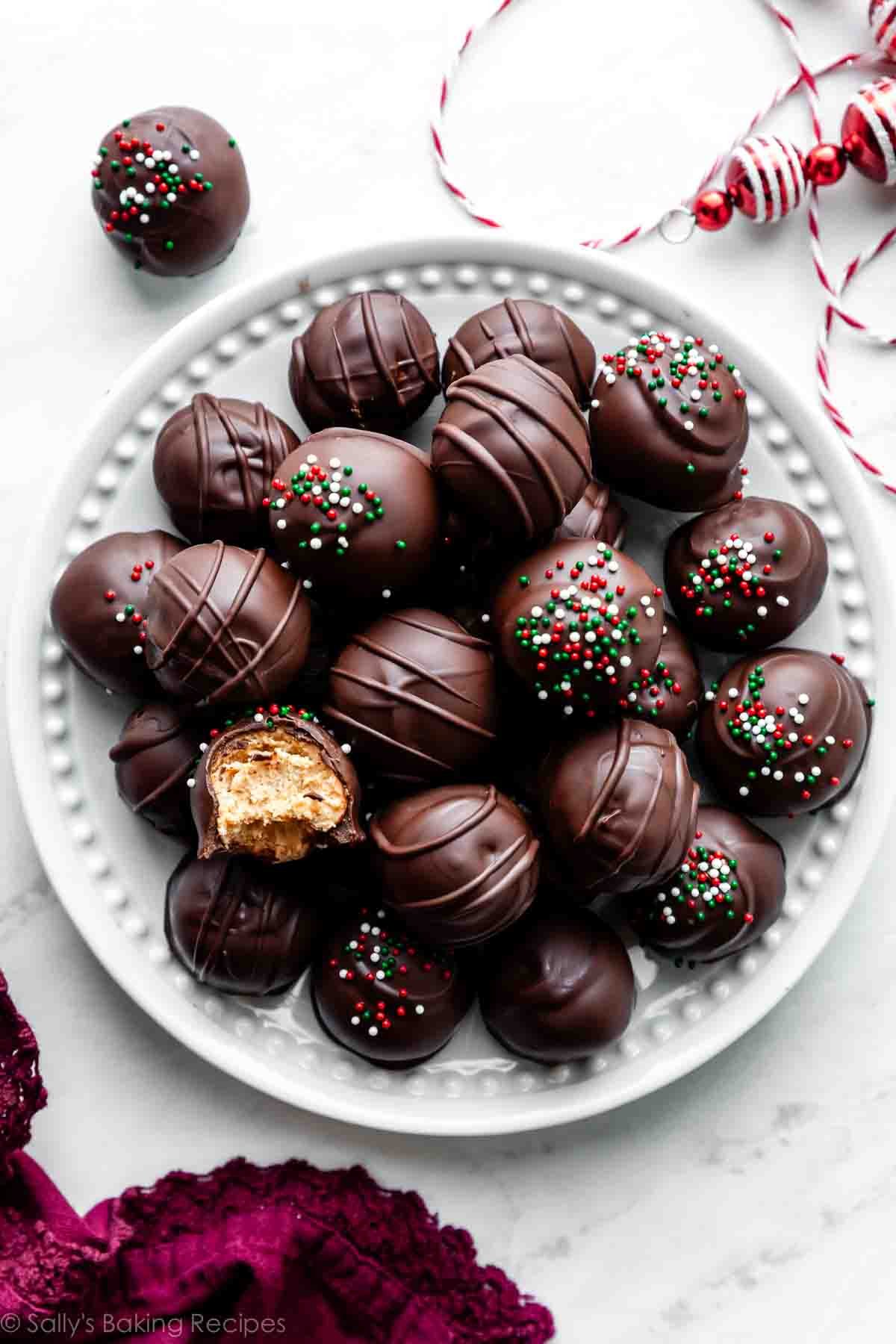
It’s always nice to have an easy no-bake treat to accompany your other Christmas cookies. It’s what I love about Oreo balls and rum balls, too. And since there’s no flour needed here, peanut butter balls are also a wonderful option when it comes to gluten-free dessert recipes.
Think of these no-bake candies as peanut butter bars in truffle form. My peanut butter bars have a bit more substance from the graham cracker crumbs. These peanut butter balls, on the other hand, have a purely creamy peanut butter filling. (And they’re even more wildly delicious than they sound, I swear.)
Best Ingredients to Use & Why:
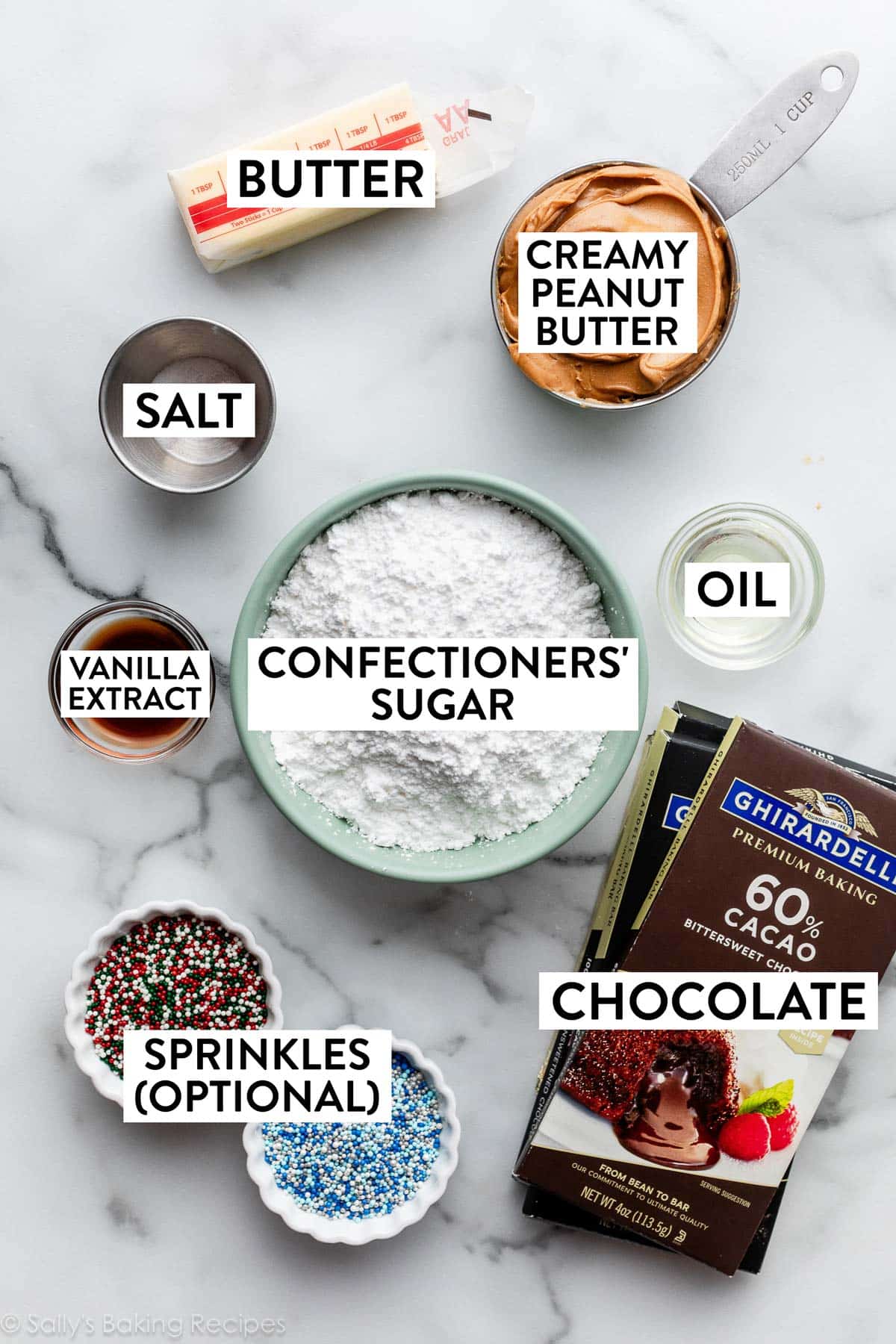
- Softened Butter: Start with room-temperature butter. Overly soft or melted butter will sabotage your efforts from the start. Good rule of thumb: let the butter sit out on the counter for 1 hour before beginning the recipe. You can use salted or unsalted butter; if using salted, no need to adjust the added salt in the recipe—I promise these are plenty sweet either way.
- Creamy Peanut Butter: As you can guess, peanut butter is the main ingredient. For the best texture, use processed creamy peanut butter such as Jif or Skippy, the same kind I recommend for peanut butter blossoms and peanut butter frosting. Natural-style peanut butter is wonderful for eating and cooking, but I do not recommend it for this recipe because the filling will be too dry and crumbly.
- Confectioners’ Sugar: Confectioners’ sugar binds everything together and adds sweetness. Without this powdery sugar, the peanut butter filling will be too liquid.
- Vanilla Extract: For a little extra flavor, use vanilla extract.
- Salt: Salt offsets the sweetness.
- Chocolate: Just as if you were making chocolate truffles or chocolate peanut butter pretzel bites, use pure baking chocolate. Do not use chocolate chips because they do not melt properly. I list all of my advice about the chocolate coating below.
- 1 Teaspoon Vegetable Oil: Melted chocolate can be a little too thick to smoothly coat the candies, so add a small splash of vegetable oil to help thin it out.
Optional: festive sprinkles, of course!
How to Make Peanut Butter Balls
Let me show you the process, so you know what to expect when it’s your turn to try these treats. First, when you beat the butter and peanut butter together, the mixture will be quite thin (below, left). After you add the remaining filling ingredients, expect a crumbly dough-like mixture (below, right).
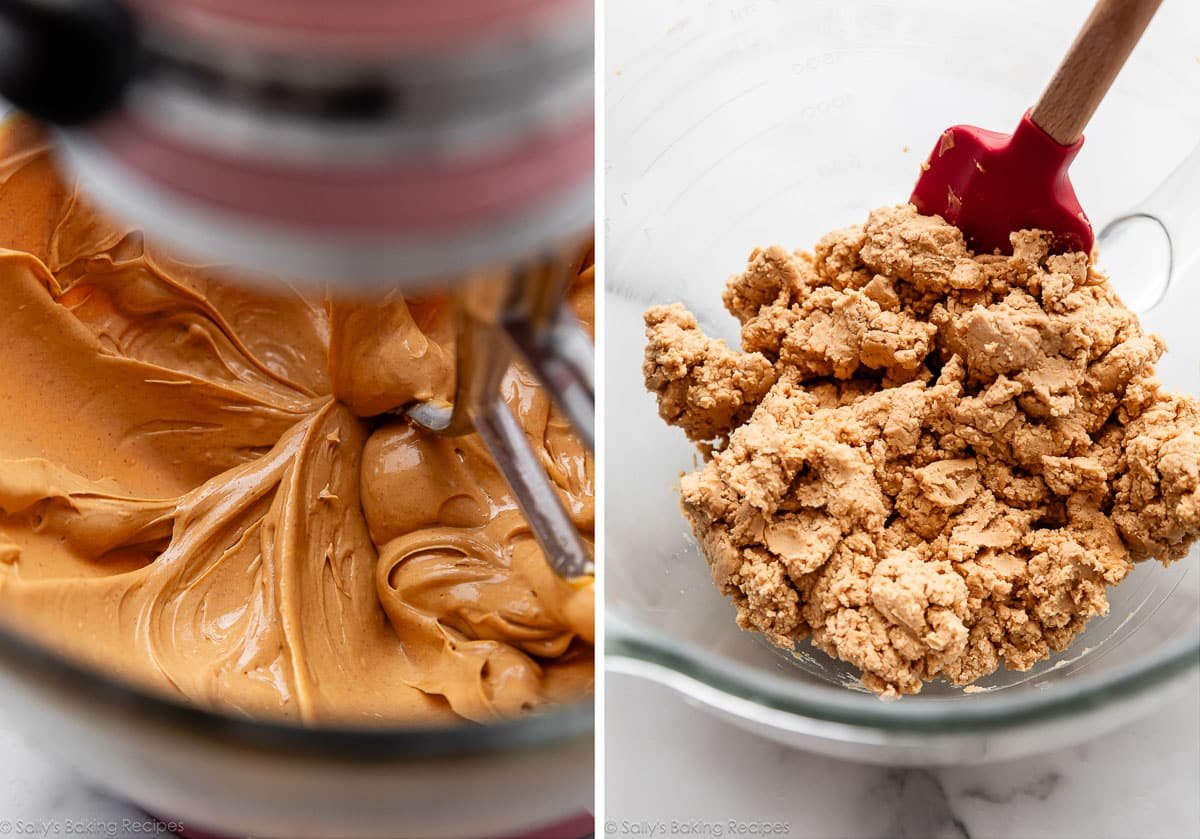
I promise the crumbly dough will come together with your hands as you roll.
Scoop and measure 1 scant Tablespoon (about 18g) each. Roll into balls.
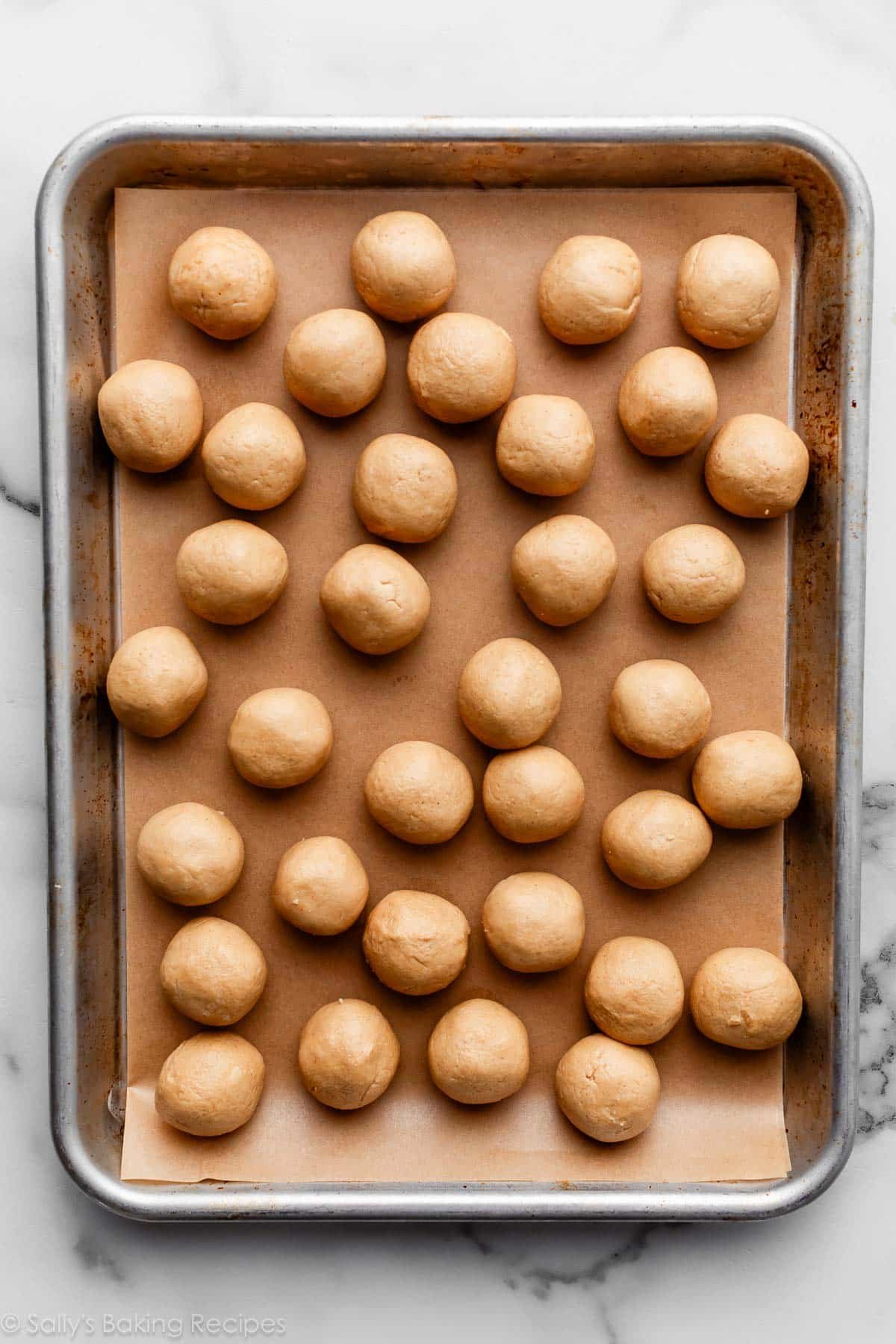
Chill the rolled balls for 1 hour in the refrigerator. Freezing them works too, but frozen peanut butter balls are difficult to coat in chocolate because the chocolate will slide off or crack. No shortcuts here, just refrigerate for 1 hour or up to 1 day.
Dip in melted chocolate. If you have any chocolate leftover, drizzle on top. Add sprinkles, if desired, and then let the chocolate set.
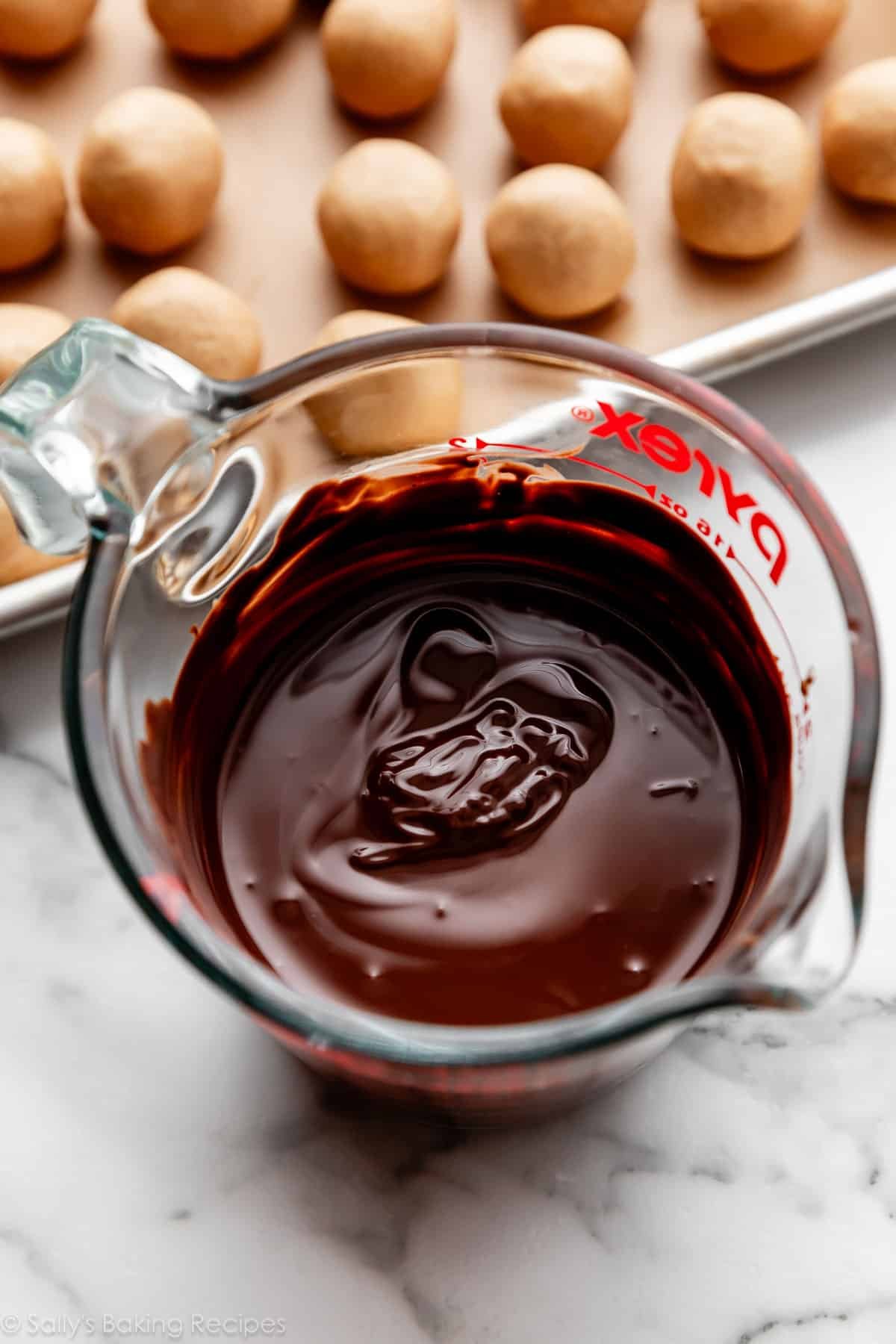
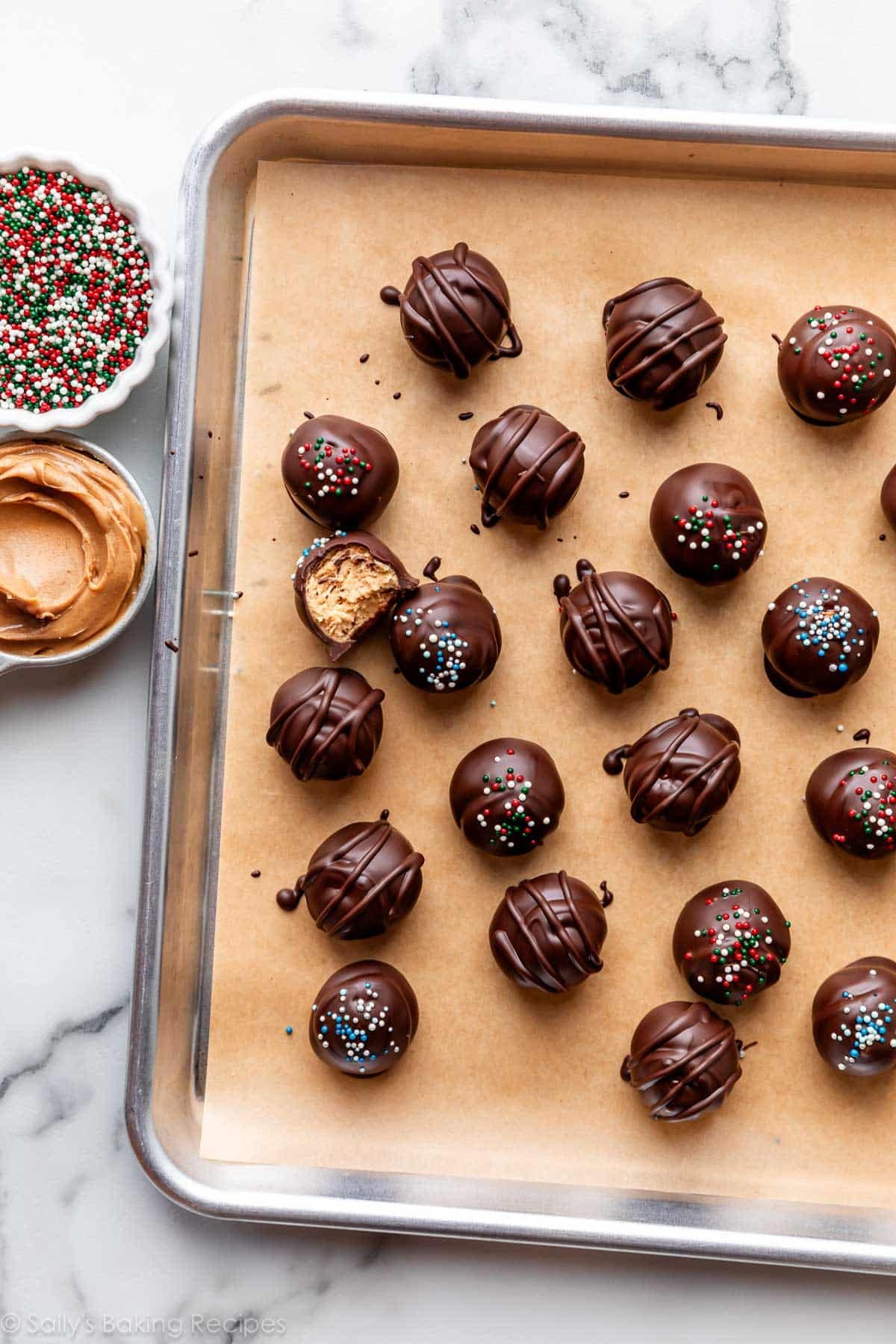
These peanut butter balls keep well for up to 2 weeks in the refrigerator and even longer in the freezer, but that’s honestly a joke. There’s no possible way they will last!
5 Success Tips for Dipping in Chocolate
I have made a lot of coated candies, and even have an entire cookbook dedicated to candy-making. In my experience, I have learned some *key* success tips for coating various candies. See below, apply these tips, and the process should be a breeze.
- Use real chocolate. For the BEST looking and tasting candies, start with real chocolate. Use the 4-ounce “baking chocolate” bars you can find in the baking aisle of the grocery store. I prefer Baker’s or Ghirardelli brands. You need to chop up three 4-ounce (113g) bars for this recipe, or 12 ounces (339g) total. Melting wafers also work, and for those, I recommend Ghirardelli brand. You can use milk, semi-sweet, dark, or even white chocolate. Be warned that using all white chocolate will produce a VERY sweet candy. Instead, I recommend dark/bittersweet or semi-sweet chocolates. Do not use chocolate chips. Save them for your chocolate chip cookies!
- Melt the chocolate properly. You can use a double boiler, but I usually just use the microwave. Place the chopped chocolate in a microwave-safe bowl or glass liquid measuring cup. Microwave in 20-second increments, stirring after each. Chocolate is temperamental, so always melt with care. I do not recommend tempering the chocolate for this recipe. Tempered chocolate isn’t refrigerated, and due to the butter in the filling, these candies should be refrigerated.
- Let the chocolate cool down for a few minutes. Otherwise it will melt the cold filling.
- Use a dipping tool to help. I use this spiral dipping tool for dipping chocolate truffles and Oreo balls, and it works just as well here. Place a peanut butter ball in the melted chocolate, and lift it back out again with the dipping tool. Quickly flip it upside down onto a lined baking sheet. If you don’t have a dipping tool, simply use a fork to lift the dipped ball out of the chocolate and use a toothpick (or another fork) to slide the ball onto the lined baking sheet.
- Allow the chocolate to set. Top the still-wet chocolate with sprinkles, if using, and if you have leftover chocolate, feel free to drizzle it on top—you can use a spoon or squeeze bottle for that. Place the baking sheet with the chocolate-covered peanut butter balls in the refrigerator to set the chocolate.
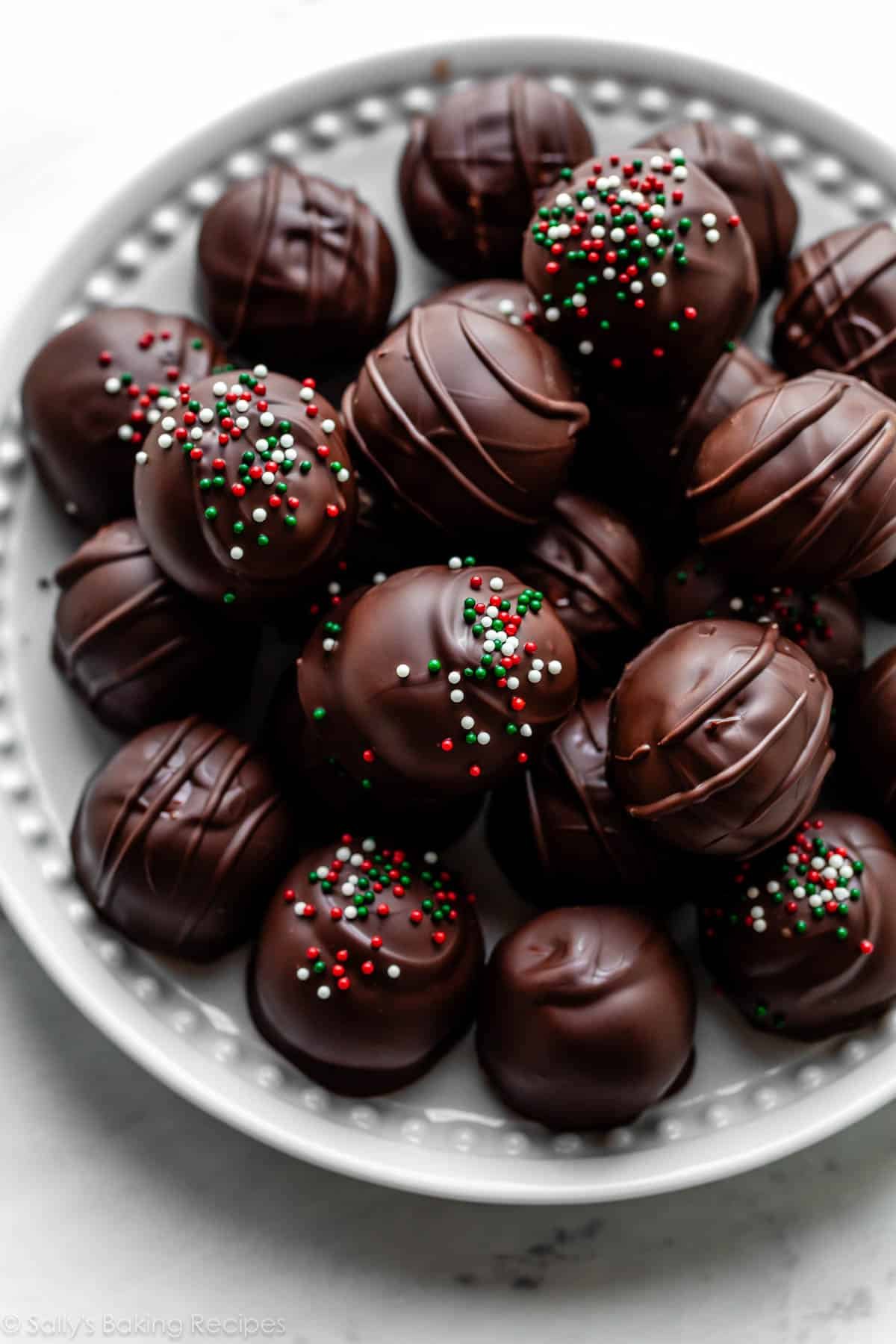
If your butter was too soft or if the peanut butter you’re using is too thin, the filling can get a little soft and sticky as you’re rolling. The refrigerator can fix that—stop what you’re doing and chill the bowl of filling for 15 minutes in the refrigerator before trying again to roll into balls.
If the filling gets a little crumbly, keeping molding it and mashing it between your hands. The warmth of your hands can help bring it back together.
1 teaspoon of vegetable oil thins out the chocolate so it’s the best consistency for dipping. If you find your chocolate is still too thick, add a little more vegetable oil. Coconut oil works too, but I recommend vegetable oil for best results.
It’s too thick. You want thinned-out melted chocolate. See above.
This is an easy fix! First, make sure you are working quickly. Second, keep the chocolate fluid by re-heating in the microwave for 10 seconds or use a double boiler. If you don’t have a double boiler, spoon the chocolate into a heatproof glass bowl set over a pot of simmering water. This keeps the chocolate slightly warm. Don’t let the water touch the bottom of the bowl.
The chocolate is too hot. Let it sit for a few minutes to slightly cool down.
If the peanut butter balls are softening and losing their shape as you’re dipping, put them back in the refrigerator (on the lined baking sheet) for 5–10 minutes and then try again.
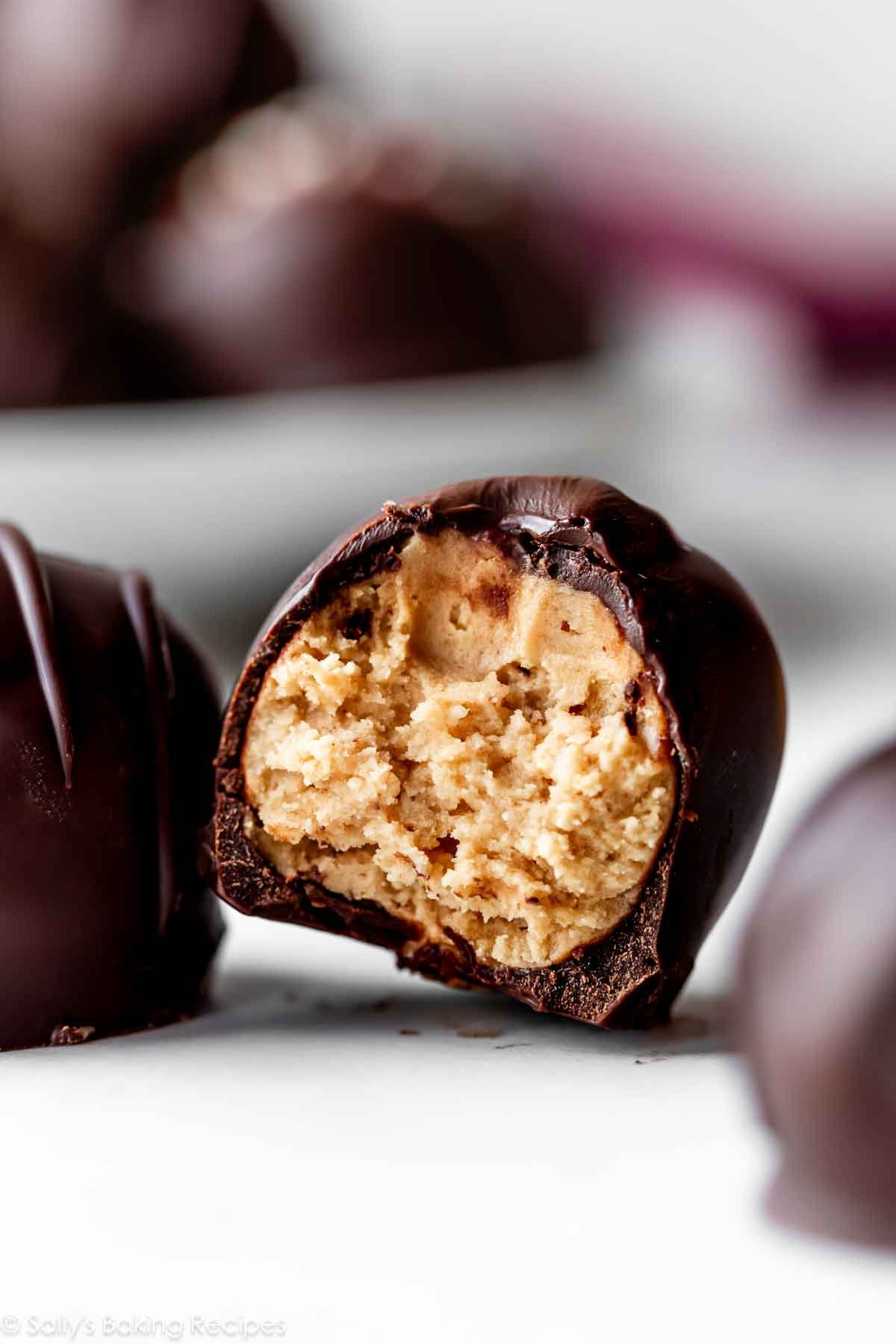
Wait until you taste them straight out of the refrigerator. Have you ever had a cold Reese’s peanut butter cup? It’s like that, but better.
More Peanut Butter + Chocolate Recipes
- Peanut Butter Blossoms
- Scotcheroos
- Peanut Butter Cup Tart
- No-Bake Cookies
- Peanut Butter Chocolate Chip Cookies
- Monster Cookies
- Peanut Butter Cupcakes
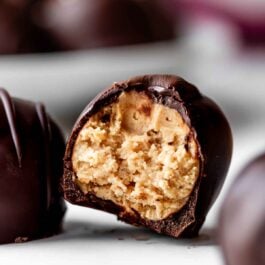
Peanut Butter Balls (Truffles)
- Prep Time: 30 minutes
- Cook Time: 0 minutes
- Total Time: 1 hour, 30 minutes
- Yield: 32-35 balls
- Category: Desserts
- Method: No Bake
- Cuisine: American
Description
Using only a few simple ingredients, these peanut butter balls come together in a snap. Follow the recipe closely and review the chocolate dipping success tips, as well as the recipe notes below before beginning.
Ingredients
- 6 Tablespoons (85g) unsalted butter, softened to room temperature
- 1 cup (250g) creamy peanut butter (not natural style)
- 2 and 1/2 cups (300g) confectioners’ sugar
- 1/2 teaspoon pure vanilla extract
- 1/8 teaspoon salt
- 12 ounces (3 4-ounce bars) semi-sweet chocolate bars (339g), coarsely chopped*
- 1 teaspoon vegetable oil (see Note)
- optional: sprinkles for topping
Instructions
- Line a large baking sheet with parchment paper or a silicone baking mat. Set aside.
- With a handheld or stand mixer fitted with a paddle attachment, beat the butter on medium-high speed until creamy and smooth, about 2 minutes. Add the peanut butter and beat until combined, about 1 minute. If you notice any small chunks of butter, don’t worry—the mixture will smooth out. Add the confectioners’ sugar, vanilla extract, and salt, and beat on low speed for 2 minutes until everything is combined. The mixture will be a little soft and crumbly.
- Roll peanut butter dough into 1-inch balls (about 1 scant Tablespoon or 18g of dough each) and place on the baking sheet. Keep working and rolling the dough in your hands until the peanut butter balls come together. You should have about 32-35 balls total. The mixture can be a little crumbly, but the warmth of your hands will bring it together. If you find the peanut butter mixture becoming too soft to handle, chill in the refrigerator for 15 minutes. Alternatively, you can powder your hands with confectioners’ sugar, which helps prevent the filling from sticking to your hands.
- Chill the shaped peanut butter balls in the refrigerator for at least 1 hour and up to 1 day. During the last few minutes of the chilling time, begin melting the chocolate and oil together. You can melt it in a double boiler or the microwave. If using the microwave: place the chocolate and oil in a medium heat-proof bowl. I recommend using a liquid measuring cup because its depth makes dipping really easy. Melt in 20-second increments in the microwave, stirring after each increment, until completely melted and smooth. Let the warm chocolate sit for 6–8 minutes to cool slightly before dipping, otherwise it will melt the shaped peanut butter balls.
- Coat with chocolate: Remove peanut butter balls from the refrigerator. Working with 1 at a time, submerge into the chocolate, then carefully lift out using a fork or the spiral candy dipping tool. Tap the fork/tool gently on the side of the bowl/measuring cup to rid excess chocolate. If you used a fork, use a toothpick or a 2nd fork to help you slide the ball off of the fork and onto the baking sheet. If you used the dipping tool, just invert the ball onto the baking sheet. (See video tutorial for how I do this.) I reheat any leftover chocolate and use a spoon or squeeze bottle to drizzle on top of the coated balls. If desired, lightly sprinkle each with sprinkles while chocolate is still wet.
- Refrigerate coated peanut butter balls for 30 minutes or until chocolate has completely set before serving.
- Store in an airtight container at room temperature for 2 days or in the refrigerator for up to 2 weeks. The filling can get a little soft, so they taste best right out of the refrigerator. We love them right out of the freezer, too!
Notes
- Make Ahead & Freezing Instructions: You can start this recipe 1 day ahead of time. The shaped filling can be chilled in the refrigerator for up to 1 day prior to coating. The coated peanut butter candies can be frozen. Freeze the coated candies for up to 3 months. Thaw overnight in the refrigerator.
- Special Tools (affiliate links): Electric Mixer (Handheld or Stand) | Baking Sheet | Silicone Baking Mat or Parchment Paper | Medium Cookie Scoop or Digital Scale | Double Boiler or Liquid Measuring Cup | Candy Dipping Tool | Squeeze Bottle
- Butter: I use unsalted butter in this recipe, though I’ve made them plenty of times before with salted butter. No need to adjust the salt in the filling, though feel free to taste the filling before adding the salt and only add a pinch if desired. Because the filling and coating are so sweet, I never adjust the salt if using salted butter.
- Can I Use Crunchy Peanut Butter? Creamy/smooth is best because crunchy yields a very crumbly filling that’s difficult to mold. If crunchy is all you have, you can make it work in a pinch—just be warned the filling mixture will be super crumbly and you’ll really have to work it with your hands to mold into balls.
- Chocolate: For the best looking and tasting candies, use 4-ounce “baking chocolate” bars found in the baking aisle. I prefer Bakers or Ghirardelli brands. You need 3 4-ounce bars for this recipe, 12 ounces total. You can use milk, semi-sweet, or bittersweet chocolates. You could also use chocolate melting wafers, such as Ghirardelli brand. Candy melts or almond bark work too, but they don’t taste like real chocolate. Do not use chocolate chips because they contain stabilizers preventing them from melting into the correct consistency for coating.
- Coating/Melting Chocolate: See all my troubleshooting tips above in the post.
- Oil: Vegetable oil helps thin out the chocolate so it easily coats the candies. If you’re using chocolate melting wafers, you do not need to add oil. Coconut oil works, but the chocolate isn’t quite as thin. I’ve found vegetable oil it the best choice. Do not use butter.
- Do Not Temper: I do not recommend tempering the chocolate for this recipe. Tempered chocolate should not be refrigerated and due to the fresh ingredients in the filling, these candies must be refrigerated.
- Update in 2023: I slightly updated the filling in 2023. The recipe used to call for 8 Tablespoons butter (113g) and 3 cups confectioners’ sugar (360g). I reduced both slightly to the amounts you see above, for less sweetness, and more peanut butter flavor. The filling now matches my popular peanut butter eggs.





















What did i do wrong? The chocolate is SO thin and despite allowing excess chocolate to drip off, i still ended up with pools of chocolate at the bottom of base.
Overall, delicious, but disappointed with the appearance of the final product. What did i do so wrong? 🙁
Hi Jess, happy to help troubleshoot. What kind of chocolate did you use?
This is so good, though I can’t have too many cause they’re so sweet. If theres a good substitute for the icing sugar then I’d be in heaven
Hi Anna, the confectioners’ sugar is key here, so we don’t recommend any swaps. Glad you enjoyed them!